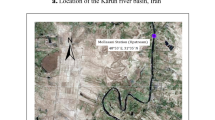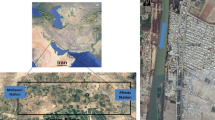Abstract
Being one of the preliminary in-situ testing methods, aquifer pumping tests would provide significant insights which form a basis for the aquifer characterization. The use of Darcian based flow models to describe the groundwater flow would be ineffective for the aquifer pumping tests under certain circumstances. Non-Darcian flow models could therefore construct more accurate portrayal of physical reality for the assessment of aquifer testing. The interpretation of flow parameters obtained from non-Darcian flows via classical curve matching methods seems extremely difficult to acquire a unique match since the well-defined type curves have not been developed. In this study, an evolutionary optimization based algorithm, called as Particle Swarm Optimization (PSO), was established to determine the flow parameters namely power index, storativity and the turbulent factor which serves as an apparent hydraulic conductivity. The proposed PSO based parameter estimation scheme was implemented for a number of numerical test cases and the estimation performance was evaluated by comparing with available population based algorithms. The results reveal that the PSO based estimation approach is successfully able to identify the flow parameters in an accurate and fast manner. A number of sensitivity analyses were also conducted to draw the limitations of the introduced PSO based technique. The positive findings from this study pointed the potential capability of using PSO as a viable algorithm to process the complex relations in the flow.




Similar content being viewed by others
References
Abraham A, Guo H, Liu H (2006) Swarm intelligence: foundations, perspectives and applications. Stud Comput Intell 26:3–25
Basak P, Madhav MR (1979) Analytical solutions to the problems of transient drainage through trapezoidal embankments with Darcian and non-Darcian flow. J Hydrol 41:49–57
Bolado-Lavin R, Castaings W, Tarantola S (2009) Contribution to the sample mean plot for graphical and numerical sensitivity analysis. Reliab Eng Syst Saf 94(6):1041–1049
Camacho-V RG, Vasquez-C M (1992) Comment on analytical solution incorporating nonlinear radial flow in confined aquifers by Zekai Sen. Water Resour Res 28(12):3337–3338
Choi ES, Cheema T, Islam MR (1997) A new dual-porosity/dual-permeability model with non-Darcian flow through fractures. J Petrol Sci Eng 17:331–344
Domenico PA, Schwartz FW (1997) Physical and chemical hydrogeology, 2nd edn. Wiley, New York
Forchheimer P (1901) Wasserbewegung durch Boden. Z Ver Deutsch Ing 45:1782–1788
Hantush MS, Jacob CE (1955) Nonsteady radial flow in an infinite leaky aquifer. Trans Am Geophys Union 36:95
Iadevaia S, Lu Y, Morales FC, Mills GB, Ram PT (2010) Identification of optimal drug combinations targeting cellular networks: integrating Phospho-proteomics and computational network analysis. Cancer Res 70:6704–6714
Izbash SV (1931) O Filtracii V Kropnozernstom Materiale. Leningrad, USSR (in Russian)
Kabala Z (2001) Sensitivity analysis of a pumping test on a well with wellbore storage and skin. Adv Water Resour 24(5):483–504
Kennedy J, Eberhart R (1995) Particle swarm optimization. Proc. IEEE Int’l. Conf. on Neural Networks (Perth, Australia), IEEE Service Center, vol IV. Piscataway, pp 1942–2948
Lee T-C (1999) Applied mathematics in hydrology. Lewis Publishers
Mathias S, Butler A, Zhan HB (2008) Approximate solutions for Forchheimer flow to a well. J Hydraul Eng 134(9):1318–1325
Neuman SP (1972) Theory of flow in unconfined aquifers considering delay response of the water table. Water Resour Res 8(4):1031–1045. https://doi.org/10.1029/WR008i004p01031
Papadopulos IS, Cooper HH (1967) Drawdown in a well of large diameter. Water Resour Res 3(1):241–244
Plischke E (2012) An adaptive correlation ratio method using the cumulative sum of the reordered output. Reliab Eng Syst Saf 107:149–156
Poli R (2007) An analysis of publications on particle swarm optimization applications. Tech. Rep. CSM-469, Department of Computing and Electronic Systems, University of Essex, Colchester, May–November 2007
Poli R, Kennedy J, Blackwell T (2007) Particle swarm optimisation: an overview. Swarm Intell J 1(1):33–57. https://doi.org/10.1007/s11721-007-0002-0
Polubariava-Kochina P (1962) Theory of ground water movement. Princeton University Press, Princeton, New Jersey, USA (translated by J.M. De Wiest)
Qian J, Zhan H, Zhao W, Sun F (2005) Experimental study of turbulent unconfined groundwater flow in a single fracture. J Hydrol 311:134–142
Roose T, Fowler AC, Darrah PR (2001) A mathematical model of plant nutrient uptake. J Math Biol 42:347–360
Sen Z (1988) Analytical solution incorporating nonlinear radial flow in confined aquifers. Water Resour Res 24(4):601–606
Sen Z (1989) Nonlinear flow toward wells. J Hydraul Eng 115(2):193–209
Stehfest H (1970) Algorithm 368 numerical inversion of Laplace transforms. Commun ACM 13(1):47–49. https://doi.org/10.1145/361953.361969
Storn R, Price K (1997) Differential evolution: a simple and efficient heuristic for global optimization over continuous spaces. J Global Optimization 11:341–359
Tarantola S, Kopustinskas V, Bolado-Lavin R, Kaliatka A, Uspuras E, Vaisnoras M (2011) Sensitivity analysis using contribution to sample variance plot: application to a water hammer model. Reliab Eng Syst Saf 99:62–73
Teh CI, Nie X (2002) Coupled consolidation theory with non-Darcian flow. Comput Geotech 29:169–209
Theis CV (1935) The relation between the lowering of the piezometric surface and the rate and duration of discharge of well using groundwater storage. Trans Amer Geophys Union 2:519–524
Venkataraman P, Rao PRM (2000) Validation of Forchheimer’s law for flow through porous media with converging boundaries. J Hydraul Eng-ASCE 126(1):63–71
Wang F, He X-S, Wang Y, Yang SM (2012) Markov model and convergence analysis based on cuckoo search algorithm. Comput Eng 38(11):180–185
Wattenbarger RA, Ramey HJ Jr (1969) Well test interpretation of vertically fractures gas wells. J Petrol Tech AIME 246:625–632
Wen Z, Huang GH, Zhan HB (2008) An analytical solution for non-Darcian flow in a confined aquifer using the power law function. Adv Water Res 31(1):44–55
Wen Z, Huang GH, Zhan HB (2009) A numerical solution for non-Darcian flow to a well in a confined aquifer using the power law function. J Hydrol 364(1–2):99–106
Wen Z, Liu K, Zhan H (2014) Non-Darcian flow toward a larger-diameter partially penetrating well in a confined aquifer. Environ Earth Sci 72:4617. https://doi.org/10.1007/s12665-014-3359-6
Yang XS (2014) Nature-inspired optimization algorithms, 1st edn. Elsevier Science Publishers B. V, Amsterdam
Yang XS, Deb S (2009) Cuckoo search via Lévy flights. In: Proceedings of world congress on nature & biologically inspired computing (NaBIC 2009). IEEE Publications, USA, pp 210–214
Zaharie D (2009) Influence of crossover on the behavior of the differential evolution algorithm. Appl Soft Comput 9(3):1126–1138
Zhan ZH, Zhang J, Li Y, Chung HS (2009) Adaptive particle swarm optimization. IEEE Trans Syst Man Cybern B Cybern 39(6):1362–1381. https://doi.org/10.1109/TSMCB.2009.2015956
Author information
Authors and Affiliations
Corresponding author
Rights and permissions
About this article
Cite this article
Şahin, A. A Particle Swarm Optimization Assessment for the Determination of Non-Darcian Flow Parameters in a Confined Aquifer. Water Resour Manage 32, 751–767 (2018). https://doi.org/10.1007/s11269-017-1837-9
Received:
Accepted:
Published:
Issue Date:
DOI: https://doi.org/10.1007/s11269-017-1837-9




